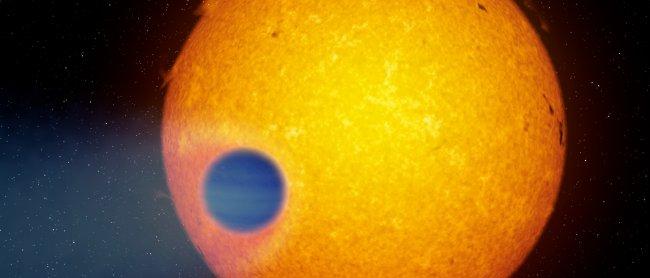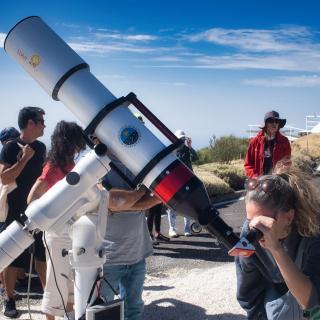A new study, led by scientists from the Instituto de Astrofísica de Canarias (IAC), reveals that the giant exoplanet WASP-69b carries a comet-like tail made up of helium particles escaping from its gravitational field propelled by the ultraviolet radiation of its star. The results of this work are published today in the journal Science.
To detect the atmosphere of the giant exoplanet WASP-69b the scientists used the CARMENES instrument, which is installed on the 3.5-meter telescope of the Calar Alto Observatory (located in Almería, Spain). This spectrograph simultaneously covers the visible wavelength range and the near infrared at high spectral resolution. This has made it possible to reveal the composition of the atmosphere of this exoplanet and to draw conclusions about the speed of the helium particles that leave the gravitational field of the planet and the length of the tail they produce.
The planet was observed during a transit, when the planet passed in front of its host star. During this event, the planet and its atmosphere eclipse part of the starlight. "We observed a stronger and longer lasting dimming of the starlight in a region of the spectrum where helium gas absorbs light," says Lisa Nortmann, a researcher at the IAC and lead author of the article published today in the journal Science. "The longer duration of this absorption allows us to infer the presence of a tail“, she adds.
But this is not the only result described in the article. The authors have also analyzed four other planets in a similar way. These are the hot exoplanets HD 189733b and HD 209458b, which have a mass similar to that of Jupiter, the extremely hot giant planet KELT-9b and the warm Neptune-sized exoplanet GJ 436b. The analysis does not show extensive helium exospheres around the last three planets, which defies previous theoretical predictions. The hot Jupiter HD 189733b, on the other hand, does reveal a clear signal of absorbing helium, although here, the helium envelope is more compact and does not form a tail.
The team also investigated the host stars of the five exoplanets using data from the European Space Agency's Multi-Mirror X-Ray Mission (ESA XMM-Newton). The results indicate that helium is detected in the atmospheres of those planets that receive the largest amount of X-ray and extreme ultraviolet radiation from their host stars. "This is a first big step towards finding out how exoplanet atmospheres evolve over time and what the distribution of masses and radii of the observed population of super-earth and mini-Neptune planets could result from", says Enric Pallé, IAC researcher and co-author of the publication.
The results of such studies could confirm that extreme radiation from the host star can strip the gaseous envelope of giant planets (similar to Jupiter or Neptune) and turn them into rocky planets with densities similar to Venus or Earth. "In the past, studies of atmospheric escape, like the one we have seen in WASP-69b, were based on space-borne observations of hydrogen in the far ultraviolet, a spectral region of very limited access and strongly affected by interstellar absorption," says Michael Salz, a researcher at the University of Hamburg and first author of a companion publication by the same team, which focuses on the details of the detection in HD 189733b to be published in the journal Astronomy & Astrophysics. "Our results” - he continues – “show that helium is a very promising new tracer to study atmospheric escape in exoplanets.”
This new line of research will enable the community of researchers specializing in characterization of exoplanet atmospheres to compare the evaporation processes in a large sample of planets and answer questions such as whether planets with ultra-short orbital periods are actually the evaporated nuclei of ancient hot Jupiters.
The CARMENES instrument was developed by a consortium of eleven Spanish and German institutions, including the IAC. It was designed to search for terrestrial type planets in the habitable zone of M-stars, the region around a star where conditions allow the existence of liquid water. The results published today demonstrate the ability of the instrument to contribute significantly to the exoplanet atmosphere research field.
Article: Nortmann, L.; Pallé, E.; Salz, M.; Sanz-Forcada, J.; Nagel, E.; Alonso-Floriano, F. J.; Czesla, S.; Yan, F.; Chen, G., Snellen I. A. G.;Zechmeister, M.; Schmitt, J. H. M. M.; López-Puertas, M.; Casasayas-Barris, N.; Bauer, F. F.; Amado, P.; Caballero, J.; Dreizler, S.; Henning, T.; Lampón, M.; Montes, D.; Molaverdikhani, K.; Quirrenbach, A.; Reiners, A.; Ribas, I.; Sánchez-López, A.; Schneider, C.; Zapatero Osorio, M. R. (2018). “Ground-based detection of an extended helium atmosphere in the Saturn‑mass exoplanet WASP-69b”. This paper will be published online by the journal Science on THURSDAY, 6 December, 2018. http://science.sciencemag.org/lookup/doi/10.1126/science.aat5348
Contact information:
- Lisa Nortmann (lnortmann [at] iac.es (lnortmann[at]iac[dot]es) - English , Deutsch)
- Enric Palle (epalle [at] iac.es (epalle[at]iac[dot]es) - Spanish, English)
- Michael Salz (msalz [at] hs.uni-hamburg.de (msalz[at]hs[dot]uni-hamburg[dot]de) - English , Deutsch)
Media files: Links to artist impression images/video: https://bit.ly/2EfdiVR. Credit: Gabriel Perez Diaz (IAC)
Interesting Links:
WASP-69b Loses its atmosphere, Art Simulation Video: https://youtu.be/auOFiackQpg
Salz, M.; Czesla, S.; Schneider, P. C.; Nagel, E.; Schmitt, J. H. M. M.; Nortmann, L.; Alonso-Floriano, F. J.; López-Puertas, M.; Lampón, M.; Bauer, F. F.; Snellen, I. A. G.; Pallé, E.; Caballero, J. A.; Yan, F.; Chen, G.; Sanz-Forcada, J.; Amado, P. J.; Quirrenbach, A.;Ribas, I.; Reiners, A.; Béjar, V. J. S.; Casasayas-Barris, N.; Cortés-Contreras, M.; Dreizler, S.; Guenther, E. W.; Henning, T.; Jeffers, S. V.; Kaminski, A.; Kürster, M.; Lafarga, M.;Lara, L. M.; Molaverdikhani, K.; Montes, D.; Morales, J. C.; Sánchez-López, A.; Seifert, W.; Zapatero Osorio, M. R.; Zechmeister, M. (2018) Detection of He I 10830 Å absorption on HD 189733 b with CARMENES high-resolution transmission spectroscopy. DOI: https://doi.org/10.1051/0004-6361/201833694
Link to the CARMENES website: http://carmenes.caha.es/
Press release from the Instituto de Astrofísica de Andalucía: The "Planet Hunt" instrument CARMENES studies evaporating atmospheres and water vapour beyond the Solar System.
Press release from Hamburg University: https://www.hs.uni-hamburg.de/index.php?lang=de
The CARMENES Consortium institutes:
- Max-Planck-Institut für Astronomie, MPIA (http://www.mpia.de/)
- Instituto de Astrofísica de Andalucía, IAA (https://www.iaa.csic.es/)
- Landessternwarte Königstuhl, LSW (https://www.lsw.uni-heidelberg.de/)
- Institut de Ciències de l'Espai, ICE (http://www.ice.csic.es/en/home)
- Insitut für Astrophysik Göttingen, IAG (http://www.uni-goettingen.de/en/203293.html
- Universidad Complutense de Madrid, UCM (http://webs.ucm.es/info/Astrof/)
- Thüringer Landessternwarte Tautenburg, TLS (http://www.tls-tautenburg.de/TLS/index.php?id=2)
- Instituto de Astrofísica de Canarias, IAC (http://www.iac.es/index.php?lang=en)
- Hamburger Sternwarte, HS (https://www.hs.uni-hamburg.de/index.php?lang=en)
- Centro de Astrobiología, CAB (http://www.cab.inta-csic.es/en/inicio)
- Centro Astronómico Hispano-Alemán, CAHA (http://www.caha.es/)



